Abstract
Overlapping deletions in chromosome 7 of the mouse are responsible for activity deficiencies of various liver-specific enzymes, including tyrosine aminotransferase (TAT). In an effort to elucidate the nature and type of action of the deleted genes, somatic cell hybridization experiments were carried out. Enzyme-deficient liver cells of homozygous mutant mice or normal liver cells of control newborn mice were hybridized with 2S Faza rat hepatoma cells and the hybrid cell colonies were analyzed for TAT activity, The results show the presence of inducible mouse TAT activity in mutant-2S Faza hybrid cells, thereby excluding the possibility that the structural gene for TAT is included in the gene sequences deleted in the mutants. Furthermore, determinations of mouse glucose-6-phosphate isomerase 1 as a marker eliminate chromosome 7 as the possible carrier of the TAT structural gene, which therefore appears to map on a different chromosome. The deletions interfering with normal enzyme activities apparently include genes other than the respective structural genes, namely those with essential functions in controlling the expression of the differentiated state of the liver cell.
Full text
PDF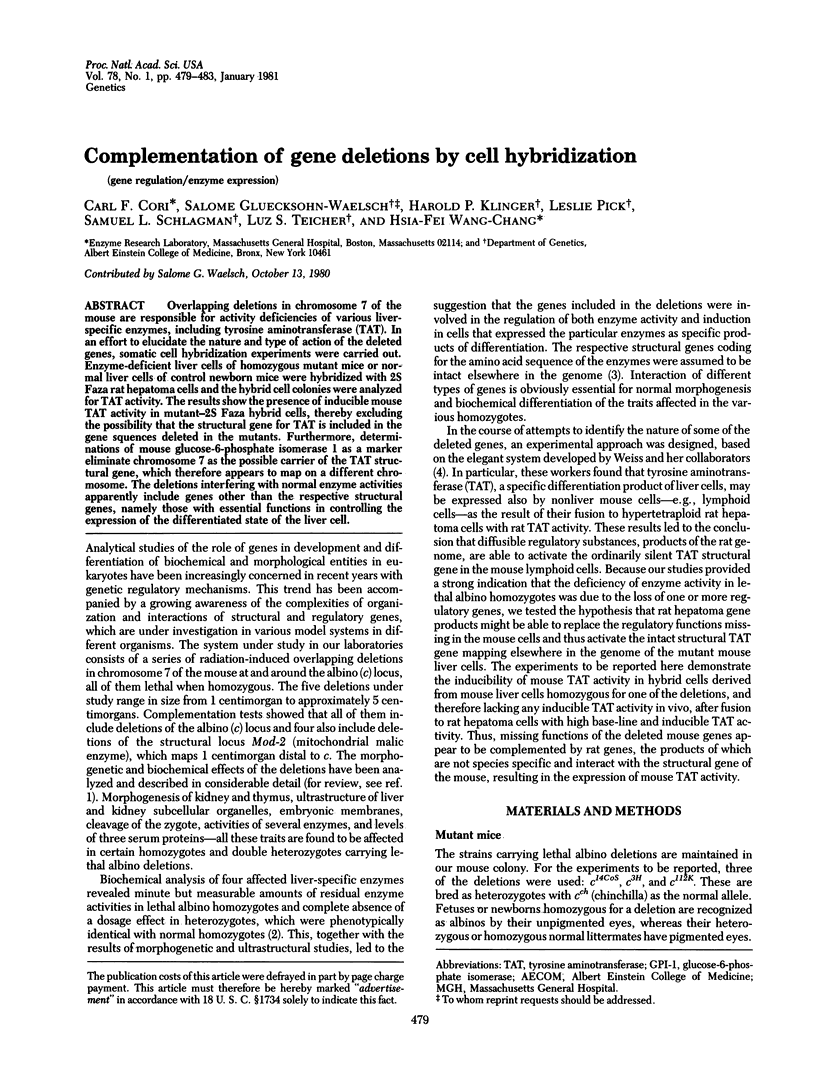
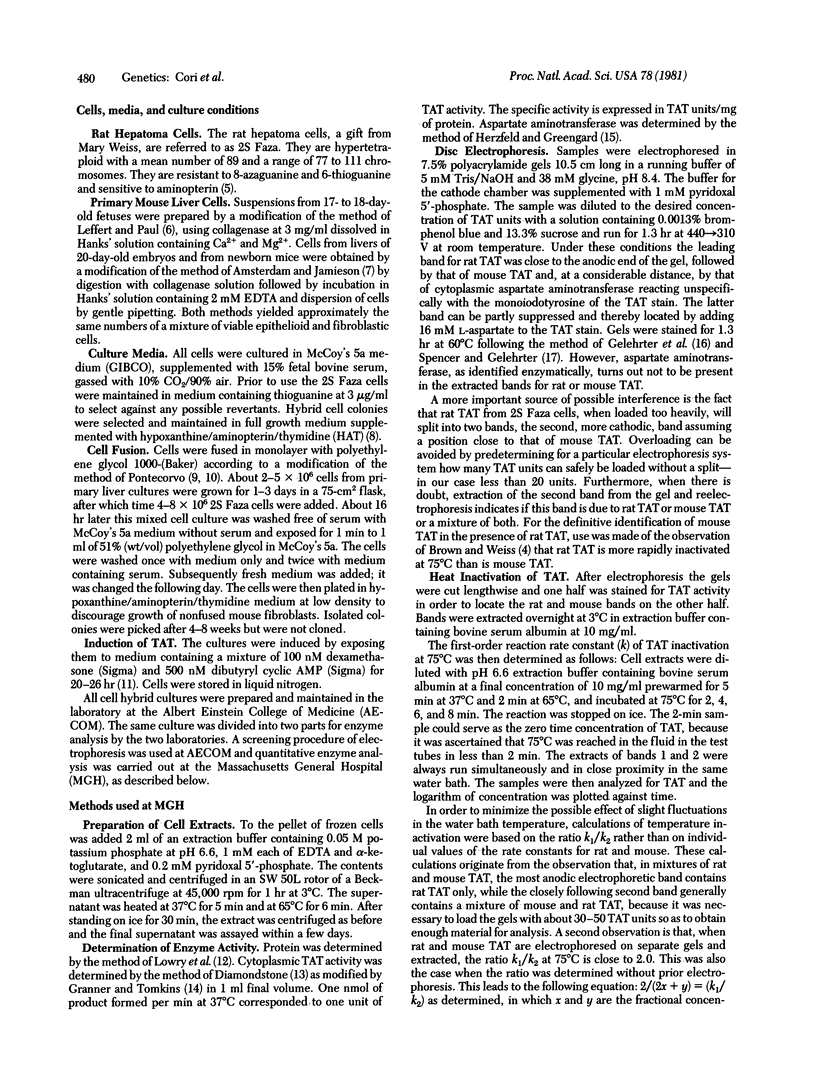
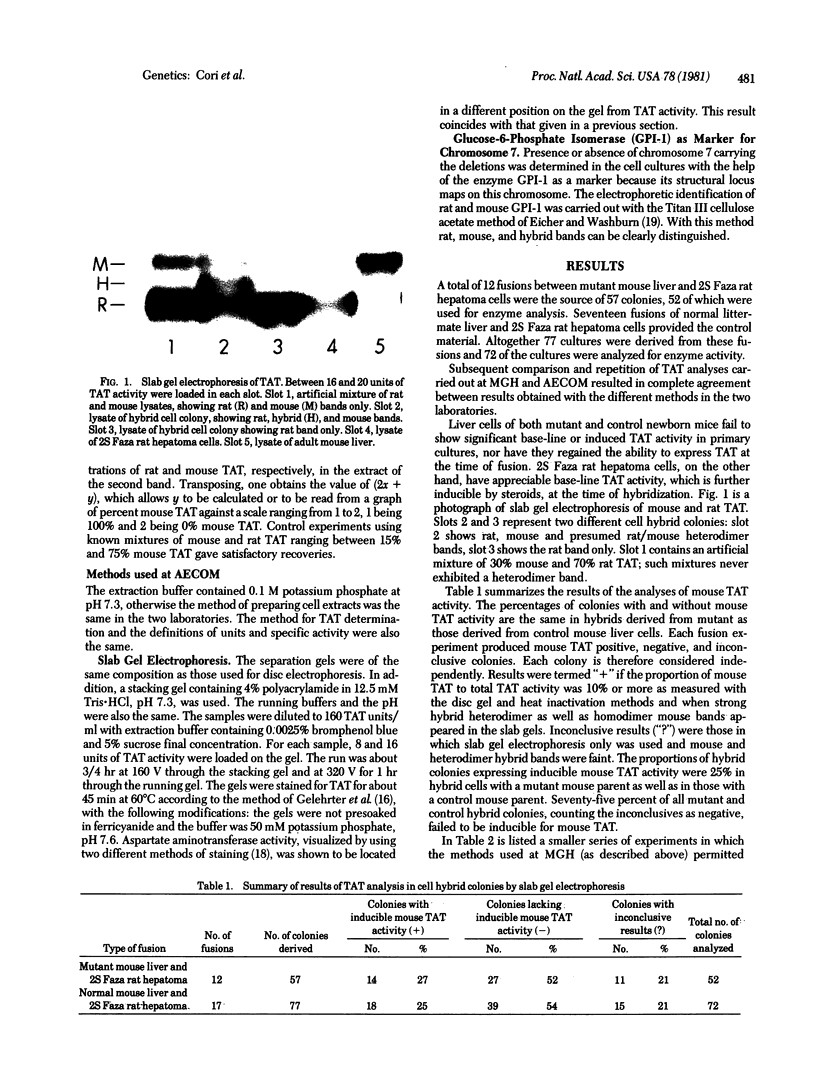
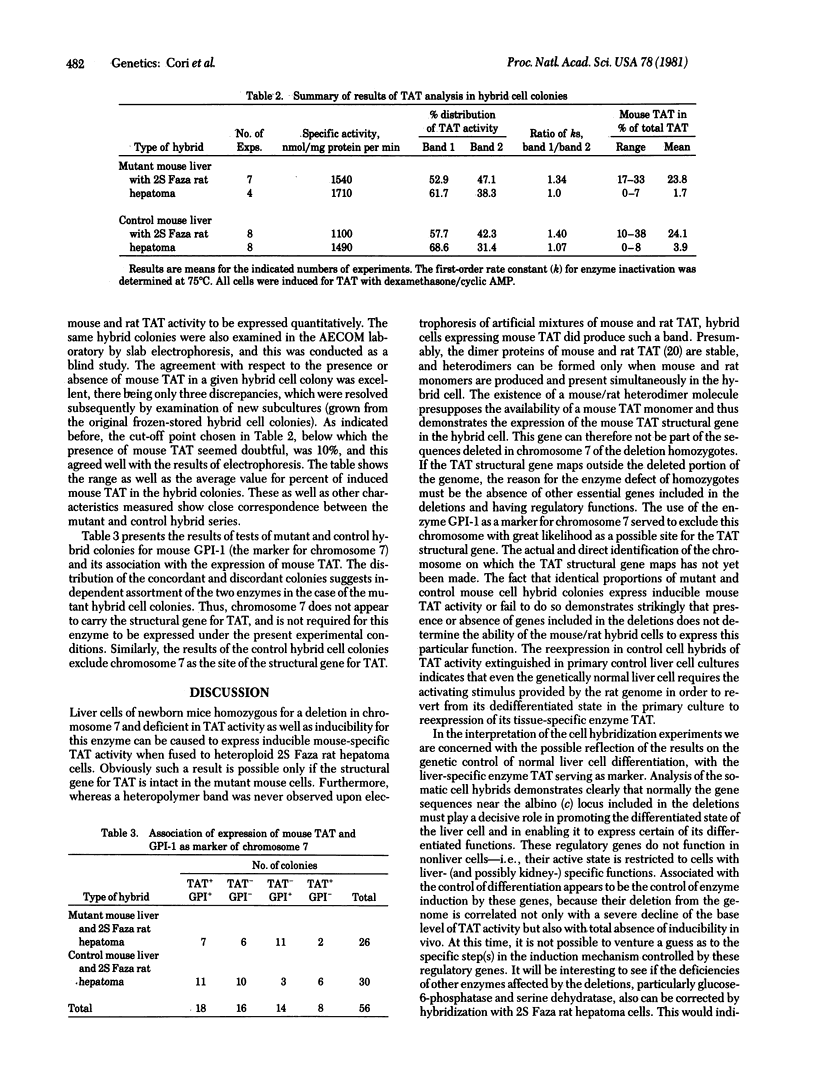
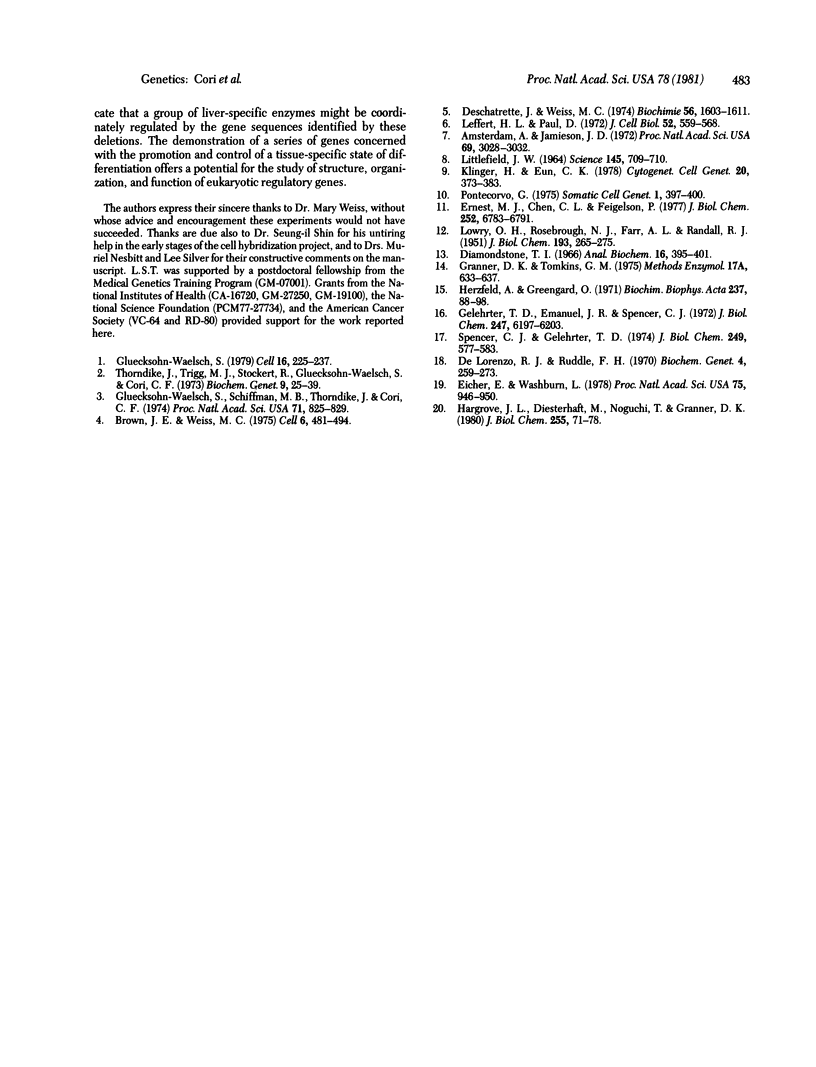
Images in this article
Selected References
These references are in PubMed. This may not be the complete list of references from this article.
- Amsterdam A., Jamieson J. D. Structural and functional characterization of isolated pancreatic exocrine cells. Proc Natl Acad Sci U S A. 1972 Oct;69(10):3028–3032. doi: 10.1073/pnas.69.10.3028. [DOI] [PMC free article] [PubMed] [Google Scholar]
- DeLorenzo R. J., Ruddle F. H. Glutamate oxalate transaminase (GOT) genetics in Mus musculus: linkage, polymorphism, and phenotypes of the Got-2 and Got-1 loci. Biochem Genet. 1970 Apr;4(2):259–273. doi: 10.1007/BF00485777. [DOI] [PubMed] [Google Scholar]
- Deschatrette J., Weiss M. C. Characterization of differentiated and dedifferentiated clones from a rat hepatoma. Biochimie. 1974;56(11-12):1603–1611. doi: 10.1016/s0300-9084(75)80286-0. [DOI] [PubMed] [Google Scholar]
- Eicher E. M., Washburn L. L. Assignment of genes to regions of mouse chromosomes. Proc Natl Acad Sci U S A. 1978 Feb;75(2):946–950. doi: 10.1073/pnas.75.2.946. [DOI] [PMC free article] [PubMed] [Google Scholar]
- Ernest M. J., Chen C. L., Feigelson P. Induction of tyrosine aminotransferase synthesis in isolated liver cell suspensions. Absolute dependence of induction on glucocorticoids and glucagon or cyclic AMP. J Biol Chem. 1977 Oct 10;252(19):6783–6791. [PubMed] [Google Scholar]
- Gelehrter T. D., Emanuel J. R., Spencer C. J. Induction of tyrosine aminotransferase by dexamethasone, insulin, and serum. Characterization of the induced enzyme. J Biol Chem. 1972 Oct 10;247(19):6197–6203. [PubMed] [Google Scholar]
- Gluecksohn-Waelsch S. Genetic control of morphogenetic and biochemical differentiation: lethal albino deletions in the mouse. Cell. 1979 Feb;16(2):225–237. doi: 10.1016/0092-8674(79)90001-1. [DOI] [PubMed] [Google Scholar]
- Gluecksohn-Waelsch S., Schiffman M. B., Thorndike J., Cori C. F. Complementation studies of lethal alleles in the mouse causing deficiencies of glucose-6-phosphatase, tyrosine aminotransferase, and serine dehydratase. Proc Natl Acad Sci U S A. 1974 Mar;71(3):825–829. doi: 10.1073/pnas.71.3.825. [DOI] [PMC free article] [PubMed] [Google Scholar]
- Hargrove J. L., Diesterhaft M., Noguchi T., Granner D. K. Identification of native tyrosine aminotransferase and an explanation for the multiple forms. J Biol Chem. 1980 Jan 10;255(1):71–78. [PubMed] [Google Scholar]
- Herzfeld A., Greengard O. Aspartate aminotransferase in fat tissues: changes with growth and hormones. Biochim Biophys Acta. 1971 Apr 20;237(1):88–98. doi: 10.1016/0304-4165(71)90033-x. [DOI] [PubMed] [Google Scholar]
- Klinger H. P., Eun C. K. Mass production of human x rodent cell hybrids in the nude mouse--extent of chromosome and gene marker stability. Cytogenet Cell Genet. 1978;20(1-6):373–383. doi: 10.1159/000130865. [DOI] [PubMed] [Google Scholar]
- LITTLEFIELD J. W. SELECTION OF HYBRIDS FROM MATINGS OF FIBROBLASTS IN VITRO AND THEIR PRESUMED RECOMBINANTS. Science. 1964 Aug 14;145(3633):709–710. doi: 10.1126/science.145.3633.709. [DOI] [PubMed] [Google Scholar]
- LOWRY O. H., ROSEBROUGH N. J., FARR A. L., RANDALL R. J. Protein measurement with the Folin phenol reagent. J Biol Chem. 1951 Nov;193(1):265–275. [PubMed] [Google Scholar]
- Leffert H. L., Paul D. Studies on primary cultures of differentiated fetal liver cells. J Cell Biol. 1972 Mar;52(3):559–568. doi: 10.1083/jcb.52.3.559. [DOI] [PMC free article] [PubMed] [Google Scholar]
- Pontecorvo G. Production of mammalian somatic cell hybrids by means of polyethylene glycol treatment. Somatic Cell Genet. 1975 Oct;1(4):397–400. doi: 10.1007/BF01538671. [DOI] [PubMed] [Google Scholar]
- Spencer C. J., Gelehrter T. D. Pseudoisozymes of hepatic tyrosine aminotransferase. J Biol Chem. 1974 Jan 25;249(2):577–583. [PubMed] [Google Scholar]
- Thorndike J., Trigg M. J., Stockert R., Gluecksohn-Waelsch S., Cori C. F. Multiple biochemical effects of a series of x-ray induced mutations at the albino locus in the mouse. Biochem Genet. 1973 May;9(1):25–39. doi: 10.1007/BF00485588. [DOI] [PubMed] [Google Scholar]



